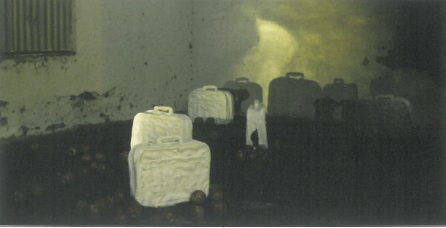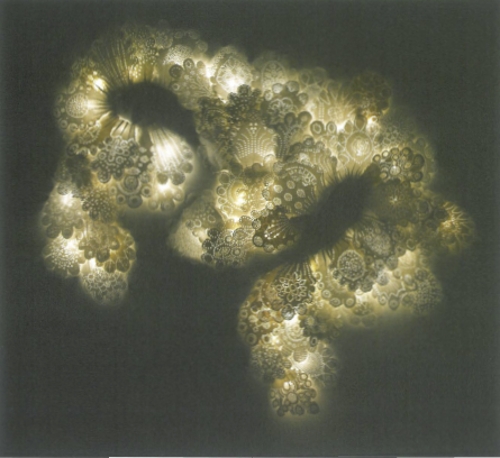
Bloom: to flower, a time or state of flowering, a healthy or flourishing condition, in its prime, an organic outbreak, a white powdery coating on certain fruits, metals etc.
Although past its theatrical prime the Queens Theatre has been given a new lease of life as an exhibition space in Adelaide's CBD. The site, in its various states of darkness and decay, provided a sympathetic backdrop to the exhibition Bloom which dealt with life, inevitably subject to cyclical change wrought by the passing of time. The works evoked a sense of proliferation and its counterpoint, the ephemeral; a bursting forth into new territories and collapsing back into memory.
The artists classified the tending to group concerns as co-curation. These concerns included; the cross pollination of concepts, culling and the interrelation between work and space.
Electronic technologies, such as video and slide projection, now commonplace in exhibitions, did not add a contemporary spin to the exhibition but worked in conjunction with theatrical spot-lighting to illuminate the work towards the Pronk of a Dutch still life; dramatically lit, the exaggerated luxury of decomposing forms reconstructed meaning.
The individual works appeared as a series of vignettes; a series of small narratives without clear-cut borders. The title of Kaylie Weirs' work, Unpalatable Memory, could be reassigned to Anna Hughes' installation Beside History. Hughes' installation dealt with the passing of her father due to complications with throat cancer. Both nurture and the abject were signified within a black orchid-like form derived from a schematic drawing of the throat. The drawing was flayed, folded out, mounted and spotted with over a thousand nodules, which upon closer inspection revealed themselves to be casts of the artist's nipples.
Bringing to mind the silver-tagged bones of Jenny Holzer's Lustmord 1993-1994 was Hughes' vertiginous construction of raw pine planks bolted together by metal wing nuts. This assemblage was comprised of numerous individual units hinged together to represent the pelvis with legs attached. As with Holzer's work, the individual units could be reconfigured for future display. Both Hughes' and Holzer's 'bone' works might be interpreted as memorials to war but are undeniably expressions of personal loss and mourning. A concertina of fabric or 'bellows' attached to another single pelvic unit exemplified expansion and contraction and embodied the concept of Bloom.
Kaylie Weir presented a series of familiar but fractured pantomimes. 'Unpacking memories' from childhood, a toffee suitcase slowly melted leaving a sticky trail, a deceptive apple was bitten, a child ventured unguided towards the unknown. An abundance of decaying apples, 'units of thought', provided olfactory stimulation and induced another layer of associations. More apples were packed inside a type of doll's house. The result was an Alice in Wonderland hallucinogenic distortion of scale perhaps revealing Weirs' interest in mental disorder.
Lisa Harms' immersive mixed media installation, Flightpatterns Flocking recalled the cloying age of Victoriana, bringing together gardenesque and parlour pursuits; nature walks, bird watching, flower forcing, sewing and music box dancing. Her video projection of flocks of birds superimposed over a plush velvet wallpaper design was manipulated to produce the mesmerising effect of looking through a kaleidoscope. By projecting word puns eg 'flock', she suggested a venturing beyond the fold, beyond limits. Flocked wallpaper, a static medium, was popular during an era when strict codes of behaviour were adhered to. Harms subverts Victorian principles by layering flocked paper with flying flocks of birds.
Besides the obvious association with freedom, birds, unlike humans, are guided by instinct rather than cultural convention. Harms' looped video of teenage daughter Hannah unlacing her corset, navigated the transverse territory between maternal anxiety and the acceptance of 'inevitable blooming' and bursting forth.
The exhibition was supported by an insightful and philosophical catalogue essay by artist and writer Julie Henderson. Henderson who has previously exhibited with Hughes and Harms defined Bloom as 'a returning to the known'.












